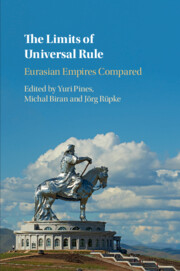Book contents
- The Limits of Universal Rule
- The Limits of Universal Rule
- Copyright page
- Contents
- Maps
- Figures
- Contributors
- Abbreviations
- Preface
- Introduction
- 1 From the Mediterranean to the Indus Valley: Modalities and Limitations of the Achaemenid Imperial Space
- 2 Limits of All-Under-Heaven: Ideology and Praxis of “Great Unity” in Early Chinese Empire
- 3 The Roman Empire
- 4 The Medieval Roman Empire of the East as a Spatial Phenomenon (300–1204 CE)
- 5 Early Islamic Imperial Space
- 6 The Mongol Imperial Space
- 7 The Territories and Boundaries of Empires
- 8 Delimiting the Realm Under the Ming Dynasty
- 9 The Expansion of the Qing Empire Before 1800
- 10 All Under the Tsar
- Index
- References
5 - Early Islamic Imperial Space
Published online by Cambridge University Press: 07 January 2021
- The Limits of Universal Rule
- The Limits of Universal Rule
- Copyright page
- Contents
- Maps
- Figures
- Contributors
- Abbreviations
- Preface
- Introduction
- 1 From the Mediterranean to the Indus Valley: Modalities and Limitations of the Achaemenid Imperial Space
- 2 Limits of All-Under-Heaven: Ideology and Praxis of “Great Unity” in Early Chinese Empire
- 3 The Roman Empire
- 4 The Medieval Roman Empire of the East as a Spatial Phenomenon (300–1204 CE)
- 5 Early Islamic Imperial Space
- 6 The Mongol Imperial Space
- 7 The Territories and Boundaries of Empires
- 8 Delimiting the Realm Under the Ming Dynasty
- 9 The Expansion of the Qing Empire Before 1800
- 10 All Under the Tsar
- Index
- References
Summary
This chapter investigates the emergence of imperial space in the early Islamic world, 7th–12th centuries, and Muslim notions of empire in this period. It examines how an imperial space was conquered under the Prophet Muhammad, Rashidun Caliphs and Umayyad dynasty, reaching its height in c.740, followed by its fragmentation under the Abbasid Caliphate (750–1258). The role of jihad in this expansion is examined, along with the institutions that bound the empire together and the reasons for its disintegration. The expansion of the frontiers of the Islamic world only began again under Turkish dynasties, the Seljuqs, Qarakhanids and Ghaznavids in the 11th century, when parts of Anatolia, Central Asia and India were conquered. Finally, this chapter considers how imperial space was visualised and represented in this period, examining the evidence of maps in manuscripts of works by Arabic geographers of the 10th–11th centuries.
- Type
- Chapter
- Information
- The Limits of Universal RuleEurasian Empires Compared, pp. 180 - 219Publisher: Cambridge University PressPrint publication year: 2021



